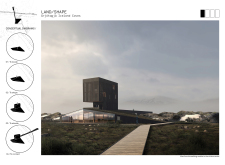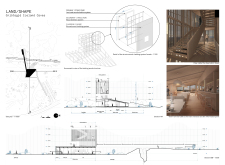5 key facts about this project
The Grjótagjá Iceland Caves project is designed to blend with the distinct geological features of Iceland. Located among volcanic formations, it aims to create a space that is both functional and connected to nature. The overall design concept is centered on sustainability and modularity, allowing the structure to interact naturally with its environment. It establishes a framework based on four guiding ideas: locating, shaping, elevating, and connecting, all of which enhance visitors’ experiences in the landscape.
Architectural Concept
At its core, the design promotes a close relationship between people and the landscape. A modular approach allows pathways to become more than just routes; they function as bridges, stairs, and platforms for walking. This flexibility encourages movement throughout the area while inviting visitors to engage with the beauty of their surroundings. Each pathway, built as a wooden deck, rests on a strong wood structure supported by foundation piles. This method ensures adaptability to the site’s varied terrain.
Environmental Sustainability
The project emphasizes sustainability as a key element. Solar panels are placed throughout the site to collect renewable energy. Rainwater recuperators are included to provide a reliable source of drinking water. The green roofs contribute to energy efficiency by enhancing thermal insulation while also promoting wildlife. These features ensure that the project meets its energy needs and aligns with eco-friendly practices.
Structural Systems
The structures consist of a laminate wood skeleton that demonstrates a focus on sustainable construction. By using wood— a renewable resource— the design minimizes its environmental impact. The building’s outer layer features burned wood cladding, which not only provides durability but also creates an aesthetic that reflects the surrounding volcanic landscape.
Visitor Experience
Central to the design are spaces for gathering, including an observation tower and a café, placed to encourage interaction among visitors. A footbridge connects these spaces, offering glimpses of the remarkable geological features nearby. This connection allows for easy movement while enhancing the overall experience, enabling visitors to appreciate the landscape's natural details and unique characteristics.






















































